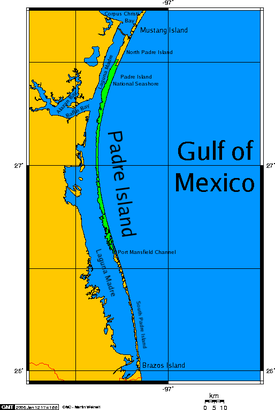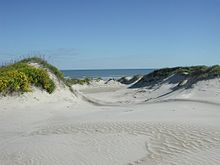Padre Island
 Padre Island map, showing theLaguna Madrewaters enclosed along the southTexascoast. | |
 | |
| Geography | |
|---|---|
| Location | Gulf of Mexico |
| Coordinates | 26°50′40″N97°22′04″W/ 26.84444°N 97.36778°W |
| Area | 209 sq mi (540 km2)(31st in U.S.) |
| Length | 113 mi (182 km) |
| Width | 1.61 mi (2.59 km) |
| Coastline | 263.22 mi (423.61 km) |
| Administration | |
United States | |
| State | Texas |
| Counties | Cameron,Kenedy,Kleberg,Nueces,Willacy |
| Additional information | |
| Official website | www |
| See:NorthandSouth Padre Island | |

Padre Islandis the largest of theTexas barrier islandsand the world's longestbarrier island.The island is located along Texas's southern coast of theGulf of Mexicoand is noted for its white sandy beaches. MeaningfatherinSpanish,it was named after FatherJosé Nicolás Ballí(c.1770-1829), who owned the island and served as a missionary priest and collector of finances for all the churches in theRio Grande Valley.He also founded the firstmissionin present-dayCameron County.[1]
Padre Island is the second-largest island by area in thecontiguous United States,afterLong Islandin New York on the Atlantic Coast. It is about 113 miles (182 km) long[2][3]: 186 and 1.8 miles (3 km) wide,[4]stretching from the city ofCorpus Christi,in the north, to the resort community ofSouth Padre Islandin the south. The island is oriented north-south, bordered by theGulf of Mexicoon the east andLaguna Madreon the west. The island's northern end connects toMustang Islandby roadway. The southern end of the island is separated fromBrazos Islandby the Brazos Santiago Pass.
The town of South Padre Island is located on its southern end, with the city of Corpus Christi situated at the northern end, but the island as a whole is sparsely populated. The central part of the island is preserved in a natural wild state asPadre Island National Seashoreand part of the lower island is protected as part of theLaguna Atascosa National Wildlife Refuge.Since 1964, the island has been divided by the artificial Port Mansfield Channel. The terms "North Padre Island"and"South Padre Island"are often used to refer to the separated portions of the island. Padre Island is included within the jurisdictions ofCameron,Kenedy,Kleberg,Nueces,andWillacycounties in Texas.
History
[edit]The island was used and occupied seasonally by theKarankawa peopleat the time of European encounter. During Spanish rule, Father José Nicolás Ballí, also known asPadre Ballí,owned the island in the 19th century, when it was known as theIsla de Santiagoland grant.[1]Padre Island had been granted in 1759 to hisSpanish colonistgrandfather, Nicolás Ballí, byKing Charles IIIofSpain.The younger Ballí's parents were both Spanish immigrants to Mexico and owned vast amounts of land by royal grants.
José Nicolás Ballí served as asecular priestand missionary; he also managed large amounts of land where he ran a ranching operation. In 1804 he founded the first ethnic Mexican settlement on the island as the town of"El Rancho Santa Cruz de Buena Vista"(later known as Lost City).[1]In 1827 after Mexico achieved independence, Father Ballí requested a clear title to the property of Padre Island.[1]His motherRosa María Hinojosa de Ballíhad made a joint application with him for eleven leagues of the island, but when reapplication was required in 1800, she withdrew her name in favor of him.[5]
After Ballí died in 1829, the government granted title to the island to him posthumously, issued jointly in his name and that of his nephew Juan José Ballí. He had bequeathed half the island to his nephew, who had worked with him on his ranch.[1]
During World War II, United States scientists considered Padre Island as one of eight candidate sites for thefirst testof anatomic bombbut choseWhite Sands Missile Rangein New Mexico for the detonation, instead.[6]
During 1953-1956, an annual 110-mile, three-day walking race was held going the length of the island, south to north, called Padre Island Walkathon. It was the first modern-eraultramarathonin America and involved up to 148 walkers, with a large mobile support staff. At the time, it claimed to be “the toughest, roughest athletic contest in the world,” with a finish rate of only 11%.[7]
Geology
[edit]
Geologically speaking, Padre Island is a young island, having formed in just the last several thousand years. It is one of 300 barrier islands stretching fromMainetoMexico.These naturalbarrier islandsact to protect the mainland from the direct onslaught of storms.
Padre Island began forming as a submergedsand barsome 4500 years ago, as shown byradiocarbon datingof shells. Geologic speculation indicates the emerged island may be 1000 to 1500 years younger.[citation needed]Barrier island origins have been debated for many years bygeologists,but it is agreed they are formed and modified by such factors assedimenttype and supply, sea-level directional changes, current and wave strength and direction, and tide magnitude.
It is theorized that Padre Island formed from offshoreshoals,with later growth aided byspitaccretion.(A spit is a long, narrow tongue of sand extending from a mainland shoreline and formed by the shoreline drifting of sediments.) After a history of shifting, abandonment and reestablishment by storm breaches, many tidal inlets were slowly closed. Short islands were joined to form today's longer islands.[citation needed]
Padre Island graphically illustrates the life and sequences of abarriershoreline: accretionary or building phase, equilibrium or stability phase, and erosion or destructional state. The northern half of Padre Island's shoreline is in equilibrium; the southern half (and much of the remaining Texas coastline) is in an erosional stage. Wind, wave and current action continue to rework and shape the island. South Padre Island has been in a destructive phase for a long time, probably having retreated landward (along with thelagoonand mainland shoreline).
All of Padre Island will probably retreat landward through long-term erosion due to three causes: interruption and decrease in sediment supply, relativesea level rise,and tropical storm activity. Today,hurricanewashovers and wind-carried sand deposited inLaguna Madrebuild Padre Island's landward side at the expense of Laguna Madre.[citation needed]
Wildlife
[edit]Birds
[edit]Flocks of migratory birds arrive at the island during either early spring or fall and winter, with thousands of birds spending the winter there or migrating through the area.[8][9]During the summer the most common birds areshoreandmarshbirdsas well as someraptorsandsongbirds.[8]

The most common birds on the Gulf beach during the year are thewillet,sanderling,black skimmer,great blue heron,double-crested cormorant,cattle egret,grey plover,laughing gull,brown pelican,reddish egret,and five species ofterns,including theleast tern,Caspian tern,black tern,Sandwich tern,androyal tern.The two periodically appearing birds nesting on the park's shores are theleast ternandpiping plover.[8]
Kemp's ridley sea turtle
[edit]In September 2007,Corpus Christi, Texaswildlifeofficials found a record 128Kemp's ridley sea turtlenests on Texas beaches, including 81 in the Padre Island National Seashore and 4 on nearbyMustang Island.Wildlife officials had released 10,594 Kemp's ridleys hatchlings along the Texascoastin 2007. The turtles are endangered due to getting caught inshrimpers' nets; they are widely hunted in Mexico as popular sources ofbootmaterial andfood.[10]
See also
[edit]References
[edit]- ^abcde"Ballí, José Nicolás".Handbook of Texas Online.Texas State Historical Society.Retrieved2015-08-15.
- ^*"Padre Island",Encyclopædia Britannica
- ^Stanley Walker(February 1961). "The Fabulous State of Texas".National Geographic.Vol. 119, no. 2.
- ^Garrison, J. R.; Williams, J.; Potter Miller, S.; Weber, E. T.; McMechan, G.; Zeng, X. (2010). "Ground-Penetrating Radar Study of North Padre Island: Implications for Barrier Island Internal Architecture, Model for Growth of Progradational Microtidal Barrier Islands, and Gulf of Mexico Sea-Level Cyclicity".Journal of Sedimentary Research.80(4): 303–319.Bibcode:2010JSedR..80..303G.doi:10.2110/jsr.2010.034.
- ^"The Balli History Time Capsule".balli.org.
- ^"Trinity Atomic Web Site".Walker, Gregory. Archived fromthe originalon 2010-04-20.Retrieved2010-08-20.
- ^Crockett, Davy (28 July 2018)."Padre Island 110-miler 1953-1956".Ultrarunning History.Retrieved27 February2022.
- ^abc"Padre Island National Seashore birds".National Park Service.Retrieved2019-07-25.
- ^"Smithsonian – Migratory Bird Project".Smithsonian National Zoological Park - Conservation Biology Institute.Retrieved2019-07-25.
- ^"Endangered Turtle Nests Found in Texas".The Washington Post.CORPUS CHRISTI, Texas. The Associated Press. September 4, 2007.Retrieved19 September2012.
External links
[edit]- Official website
- U.S. Geological Survey Geographic Names Information System: Padre Island
- Padre Islandat theHandbook of Texas
- "Automobile Traffic on Texas Beaches"

